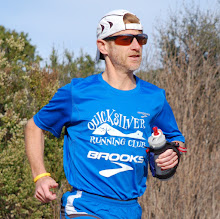At the end of September I logged two runs of 20 and 15.5 miles respectively. The pain subsided so I stayed in the 10-15K range daily after that.
In October, I ran my first race, a road half marathon. The knee was ok during the race, I was more limited by the breathing while trying to maintain a 7 min/mile pace. Knee pain again for the following few days so I took the week off.
Back in California, I went back to the track on October 20th for a 3:31:47 training marathon: the last 10 miles were painful but progress! Followed by my second race of the season, a trail half marathon this time.
November 3, 3:24:52: even a better training marathon, although even more knee pain the next day...
And this Sunday, November 10, 3:17:11! I'm prouder of this one because the elapsed time is less than a minute over, 3:17:57, so even more legit. Albeit still unofficial of course. A few other encouraging stats:
- Average pace: 7:31
- Average cadence: 187 (Garmin) - 185 (Coros)
- Average stride length: 1.15 meters (still far from my optimal marathon 1.30m-average stride of 15 years ago, but improving)
- Slightly negative split by a few seconds
- First and last mile at 8:15 (running through the neighborhood), all other miles under 8 otherwise, with a few under 7:30.
Nice trend even with the horizontal axis not at scale.
And so... what am I still complaining about when many work so hard all their running life to qualify for Boston? Well, it's the persisting pain which makes me wonder how hard and long I can really go. Putting the miles in seem so important both mentally and physically: I'm probably not enough expert, I still haven't found a way to strengthen my legs as much as when running. Not to mention the level of energy. But, am I damaging the meniscus fracture/tear more?
Now, is pain even an excuse? When I hear about other runners who share that they have been running in pain for many years, including with bone on bone articulations, it seems like I shouldn't complain indeed...
In August, Coros' marathon time prediction was 3:09. It is now down to 3:11. I still need to work on the glutes --well, always as a matter of fact-- but I believe the strength training is paying off. And I do see a path to beating these Coros predictions eventually, in good race conditions. But no rush, even with many steps at a time... And, yes, let me appreciate these improvements!
Run Happy as Brooks' tagline says! Speaking of which, still hot on my favorite running partners: Brooks, Ultimate Direction, S!Caps, VespaPower and GU Energy (disclosure: I still receive some discount on the last 2 brands).






.jpg )

1 comment:
Logging a Facebook comment for record keeping sake.
>> Jean, how do you manage a cadence of 187?! Did that come naturally to you? I’ve issues with my knees and I’m told I would benefit from higher cadence, but I’m unable to increase it!
Ah, Hugo, that's a great question as we say in the US, especially when we don't know the answer. What I can say: 1. I don't have record about which frequency I started at, short of ways to measure back then. 2. My intuition is that this comes from a lot of practice at the track. This is my refuge place to really focus on stride and pace. You know how important I believe this is for speed improvement. 3. I was going to say that it might help with a shorter stride but, as I recall, I had a 182 frequency and 1.30 or 1.35 meter stride on my good marathons. So it seems there is no correlation. 4. This funny video comes to mind for inspiration: https://www.youtube.com/shorts/jC478un3SN0 5. More seriously, I would encourage you to do many short repeats as quickly as possible, even if only 100 meters at a time but then series of 30 repeats. My intuition is that this will be a key way to break the ceiling, becoming comfortable being uncomfortable...
Post a Comment